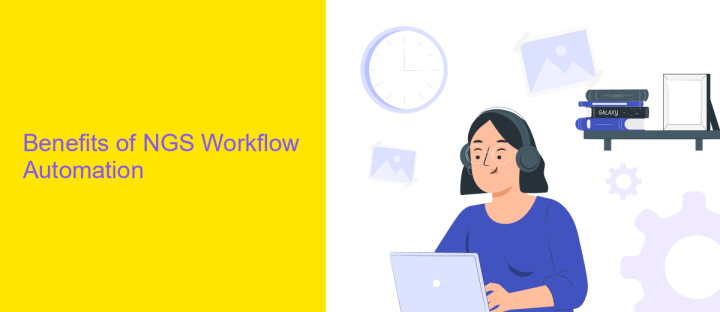NGS Workflow Automation
Next-Generation Sequencing (NGS) has revolutionized genomics research, offering unprecedented insights into DNA, RNA, and epigenetic variations. However, the complexity and volume of data generated necessitate efficient workflow automation. This article explores the key components and benefits of NGS workflow automation, highlighting how it enhances accuracy, speed, and scalability in genomic studies, ultimately driving advancements in personalized medicine and biotechnology.
Introduction
Next Generation Sequencing (NGS) has revolutionized genomic research by enabling rapid and accurate sequencing of DNA. However, the complexity of NGS workflows often poses challenges in terms of data management, processing, and analysis. Automation of these workflows can significantly enhance efficiency, reduce errors, and ensure reproducibility.
- Streamlined data acquisition and preprocessing
- Automated quality control and filtering
- Efficient data analysis and interpretation
- Integration with bioinformatics tools and databases
- Scalable and reproducible workflows
One of the key aspects of NGS workflow automation is the integration of various tools and services. Platforms like ApiX-Drive facilitate seamless integration by connecting different applications and automating data transfer processes. This not only saves time but also minimizes the risk of manual errors. By leveraging such services, researchers can focus more on data interpretation and less on mundane tasks, thereby accelerating the pace of genomic discoveries.
Benefits of NGS Workflow Automation

NGS workflow automation significantly enhances the efficiency and accuracy of genomic sequencing processes. By automating repetitive tasks, researchers can focus more on data analysis and interpretation, leading to faster and more reliable results. This automation reduces human error, ensuring higher quality data and reproducibility. Additionally, it streamlines the entire workflow, from sample preparation to data acquisition, making it easier to manage large-scale projects and collaborations.
Another key benefit is the seamless integration of various tools and platforms, which is vital for comprehensive genomic studies. Services like ApiX-Drive facilitate the integration of different software and databases, allowing for a more cohesive and efficient workflow. This not only saves time but also enhances data consistency and accessibility. Furthermore, automated workflows can be easily scaled to meet the demands of high-throughput sequencing, making it an invaluable asset for both research and clinical applications.
Challenges of NGS Workflow Automation

Automating the NGS workflow presents several challenges that require careful consideration and innovative solutions. These challenges can significantly impact the efficiency, accuracy, and reproducibility of the sequencing process.
- Data Integration: Combining data from various sources and formats can be complex and time-consuming.
- Scalability: Ensuring the system can handle increasing volumes of data without compromising performance.
- Data Security: Protecting sensitive genetic information from unauthorized access and breaches.
- Interoperability: Ensuring different software and hardware systems can communicate effectively.
- Cost: High initial investment and ongoing maintenance expenses can be prohibitive.
To address these challenges, leveraging automation tools like ApiX-Drive can streamline data integration by connecting disparate systems seamlessly. ApiX-Drive offers a user-friendly interface for setting up integrations, reducing manual effort and minimizing errors. By utilizing such services, laboratories can enhance the efficiency and reliability of their NGS workflows, ultimately leading to more accurate and timely results.
Best Practices for NGS Workflow Automation

Implementing best practices for NGS workflow automation can significantly enhance the efficiency and accuracy of genomic sequencing projects. To achieve optimal results, it is crucial to integrate robust tools and methodologies that streamline the entire process from sample preparation to data analysis.
One of the key aspects is the automation of repetitive tasks, which not only reduces human error but also saves valuable time. Leveraging cloud-based platforms and advanced software solutions can facilitate seamless integration and scalability, ensuring that your workflow remains adaptable to evolving project requirements.
- Utilize reliable automation platforms like ApiX-Drive to integrate various tools and services efficiently.
- Implement rigorous quality control checks at each stage to ensure data integrity.
- Regularly update and maintain software tools to leverage the latest advancements in technology.
- Ensure proper documentation and version control to track changes and maintain reproducibility.
By adopting these best practices, you can create a more streamlined and efficient NGS workflow, ultimately leading to more accurate and reliable results. Continuous evaluation and improvement of your automation strategies will further enhance productivity and data quality in your genomic sequencing projects.
- Automate the work of an online store or landing
- Empower through integration
- Don't spend money on programmers and integrators
- Save time by automating routine tasks
Future of NGS Workflow Automation
The future of NGS workflow automation is poised to revolutionize genomic research and clinical diagnostics. With advancements in artificial intelligence and machine learning, automated workflows will become more efficient, reducing human error and increasing throughput. Integration of cloud-based platforms will enable seamless data sharing and collaboration across global research teams. This will accelerate the pace of discovery and improve the accuracy of genomic analyses.
Moreover, the integration of various tools and services, such as ApiX-Drive, will simplify the automation process. ApiX-Drive allows for easy connection between different applications and data sources, streamlining the workflow and reducing the time required for manual data handling. This will enable researchers to focus more on data interpretation and less on technical challenges, paving the way for more innovative solutions in genomics. As these technologies continue to evolve, the future of NGS workflow automation looks promising, with the potential to significantly advance personalized medicine and other genomic applications.
FAQ
What is NGS Workflow Automation?
How can NGS Workflow Automation benefit my lab?
What steps in the NGS workflow can be automated?
How do I integrate NGS Workflow Automation into my existing lab setup?
What are the challenges in implementing NGS Workflow Automation?
Routine tasks take a lot of time from employees? Do they burn out, do not have enough working day for the main duties and important things? Do you understand that the only way out of this situation in modern realities is automation? Try Apix-Drive for free and make sure that the online connector in 5 minutes of setting up integration will remove a significant part of the routine from your life and free up time for you and your employees.


